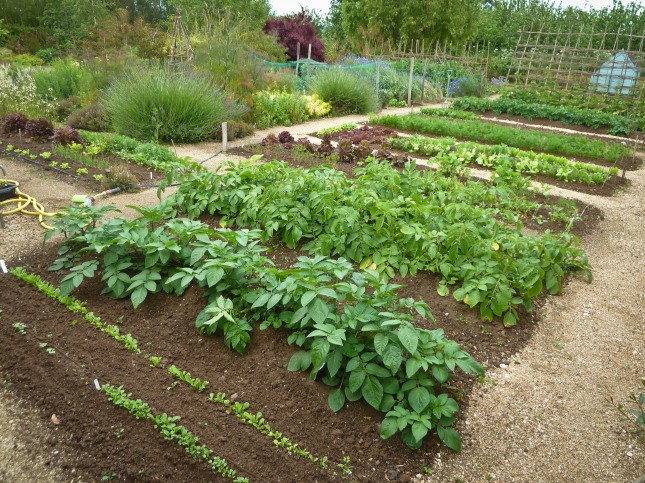Mr Middleton says: Hygiene in the garden is important. Do not allow rubbish to accumulate, except on the compost heap.
June-5th WEEK
1. Gather Beans.- The earliest dwarf French beans will now be ready for picking. They should be gathered while young and tender and not left to get stiff and stringy. It is important to keep them gathered as they become ready, then the plants will keep on bearing more. If allowed to remain and mature, the plant will throw all its energy into the development of seeds rather than producing fresh pods. When runner beans have grown to the top of their stakes the growing point should be pinched off.
2. Shallots and Garlic.- In the south, shallots will be ripening where planted in early February. The soil should be pulled away from the cloves a little to assist ripening.
3. Sow Corn Salad.- Though normally sown in August, corn salad or lamb’s lettuce can be sown now. A small sowing is advisable.
4. Liquid Manure.- Growing sea-kale will benefit from a soaking of liquid manure. (Mr Middleton suggests you collect your own from a holding tank in a farm yard but also gives details on making your own). Fill a sack with manure and suspend it in a tub of water.
5. Sow Endive and Radish.- Sow moss-curled endive now to provide an autumn crop. Make successional sowings of radish to keep up the supply.
6. Easy with the New Potatoes!- In the more southerly parts of the country, the earliest potatoes will be ready. But iit is wasteful to start digging them while they are very small. Only take up as many at a time that are needed for immediate use. Potatoes are a good cleaning crop, not so much by virtue of their habit of growth, but because of the cultural operations they need.
7. Plant Maincrop Leeks.- In the north the main planting of leeks should be made now. It is important to plant in June so as to obtain adequate growth before the winter closes down. It is important that good big plants be put out, and these should not have been left in the seed rows to check each other. If they have had a check they may run to seed early. Make another sowing of white turnips and dwarf French beans.
8. Fruit Needs Attention.- Summer pruning of wall fruit and other trained forms can begin. Plums and sweet cherries are done first, and pears soon after. Water layered strawberry runners when necessary.
What a great time to have a vegetable plot! There is so much to harvest right now; peas, beans, potatoes, salad, carrots, courgettes, herbs of all sorts and, for those who don’t suffer from rust and white rot, you will be gathering in your shallots and garlic.
I harvested the first of the new potatoes this week, Belle de Fontenay, a lovely smooth, firm, waxy potato with excellent ‘new potato’ taste. There is always that moment of anticipation when you pull up the first of the spuds and then that moment of joy when you see the lovely tubers come to the surface. I haven’t been troubled by blight at all on these potatoes but the ‘Cherie’ variety have got it. Its no big deal as they have put on some good growth and l will still get a good crop.
I have been picking loads of mange-tout as well. This is such an easy vegetable to grow but so long as you keep picking those pods you should get masses from each plant. Lovely topped and tailed, lightly steamed and served with a small knob of butter. Life doesn’t get any better!
That mini heatwave last weekend was lovely but poor Rog can’t take the heat. He had to retire to his bed and sleep it off!
On a sadder note, we lost another hen last week. I have written on here before how l let them roam freely in our field and to take their chance with Mr Fox. They never roam far tending to stay within 20m or so of their house. We went out the other evening only to come back to find a big pile of feathers on the grass. The Andalusian got it. I was going to get rid of them all the other week when they broke into my veg plot causing chaos but l couldn’t part with them. So the remaining two are kept in their run now. They seem okay with that as l move them round every two or three days to fresh grass and throw in the odd lettuce that has gone to seed which they just love.
There is a lot going on here at the moment so l will do my best to keep up to date with my blog but hopefully l will have some good news to share soon.






























